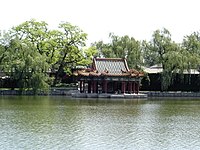Zhongnanhai
Zhongnanhai ( Chinese 中南海 , Pinyin Zhōngnánhǎi ) is a park and building complex grouped around two lakes in Beijing , which serves as the headquarters of the Communist Party of China as well as the government of the People's Republic of China .
Location and facilities
The area, which is surrounded on all sides by heavily guarded walls and gates, is located to the west of the Imperial Palace . It extends around the two eponymous lakes, the Nanhai ("southern lake") and the Zhonghai ("middle lake"). Beihai , to the north , is located outside the site and is open to the public as a recreation park.
The main entrance to Zhongnanhai is on West Chang'an Avenue, south of it . The Xinhuamen, the “Gate of the New China”, is framed by the slogans “Long live the Communist Party” and “Long live the invincible Mao Zedong ideas”. The traditional ghost wall behind the gate is decorated with the motto "Serve the people!" In Mao Zedong's original handwriting.
There are numerous buildings on the banks of the lakes. Many of them date from the different dynasties of the imperial era . Modern buildings were added mainly by the communists , such as the headquarters of the CCP Central Committee or the State Council .
Since Zhongnanhai has been the seat of government again, it has been as inaccessible to the public as the Forbidden City was once during the Qing Dynasty . After the Cultural Revolution , visitors were allowed to a limited extent from 1977 to 1985, but tickets could only be obtained through good relations with the authorities. As the domestic political situation worsened in the late 1980s, which was to culminate in the Tian'anmen massacre , Zhongnanhai was completely closed again.
history
During the Jin Dynasty , the Taiye Lake ("Lake of Great Water"), which roughly corresponded to today's Bei- and Zhonghai, was located on the site . The Daning Gong (the "Palace of the Great Peace") rose on its bank . In the Yuan dynasty , the lake was integrated into the imperial city , greatly expanded and built with a little palace architecture.
After the capital was moved from Nanjing to Beijing in the Ming Dynasty , the new Imperial Palace was built a little south of that of the Yuan period. Accordingly, the Taiye area was expanded to the south and today's Nanhai Lake was created. The earth excavated here was poured north of the imperial palace to form Jingshan , the "coal hill". The three lakes were now connected by canals spanned by bridges and henceforth formed the imperial park.
In the Qing Dynasty , the government reduced the size of the Imperial Park a little. Several emperors erected various buildings and pavilions on the lakeshore and used the area as a summer residence. The Dowager Empress Cixi even settled there permanently and only went to the actual imperial palace for ceremonial occasions.
During the Boxer Rebellion in 1900, the Russian army occupied Zhongnanhai and looted the buildings. The site later served as the headquarters of the leader of the Eight Nations Alliance . After Puyi's coronation as emperor , his father temporarily lived there as regent.
After the fall of the dynasty in 1911, Yuan Shikai , the president of the Beiyang government , set up his headquarters in Zhongnanhai; it served as a replacement for the actually favored imperial palace, which was still inaccessible as Puyi's residence. Under the Nanjing regime from 1928 to 1945, Zhongnanhai was open to the public as a park. Only the government of the People's Republic claimed the representative site again for political purposes. Many important politicians also had their own homes in Zhongnanhai.
Political importance
The heart of the People's Republic of China beats in Zhongnanhai , making it one of the largest political centers of power on earth. In some cases, like the Moscow Kremlin or the White House , the term is used as a synonym for the Chinese government, party or state power.
Accordingly, the area was also repeatedly the scene of demonstrations and protest rallies. On April 18, 1989, for example, democratically minded students held a sit-in in front of the Zhongnanhai and displayed boards with inscriptions such as “Down with the dictatorship” and “Long live democracy”. On April 20th, the police forcibly broke up the meeting.
On April 19, 1999, followers of the Falun Gong movement demonstrated in front of the site. This sit-in strike aroused government fears of another Tian'anmen incident and subsequently led to massive persecution of practitioners.
monument
Zhongnanhai has been on the list of monuments of the People's Republic of China (6-302) since 2006 .
literature
- Yipeng Jiao: Peking und Umgebung, Köln 1999, ISBN 3-7701-3677-2 , p. 97ff.
Web links
Coordinates: 39 ° 54 ′ 41 ″ N , 116 ° 22 ′ 50 ″ E


